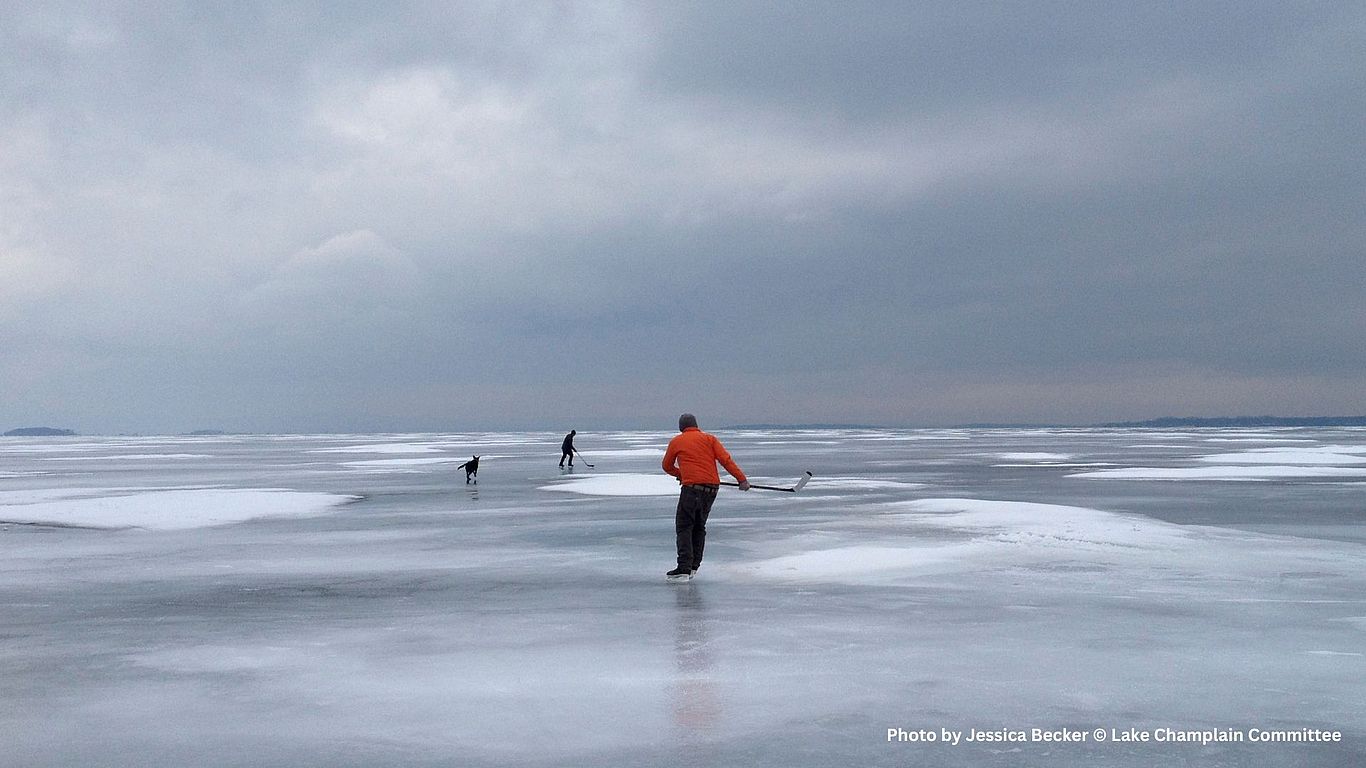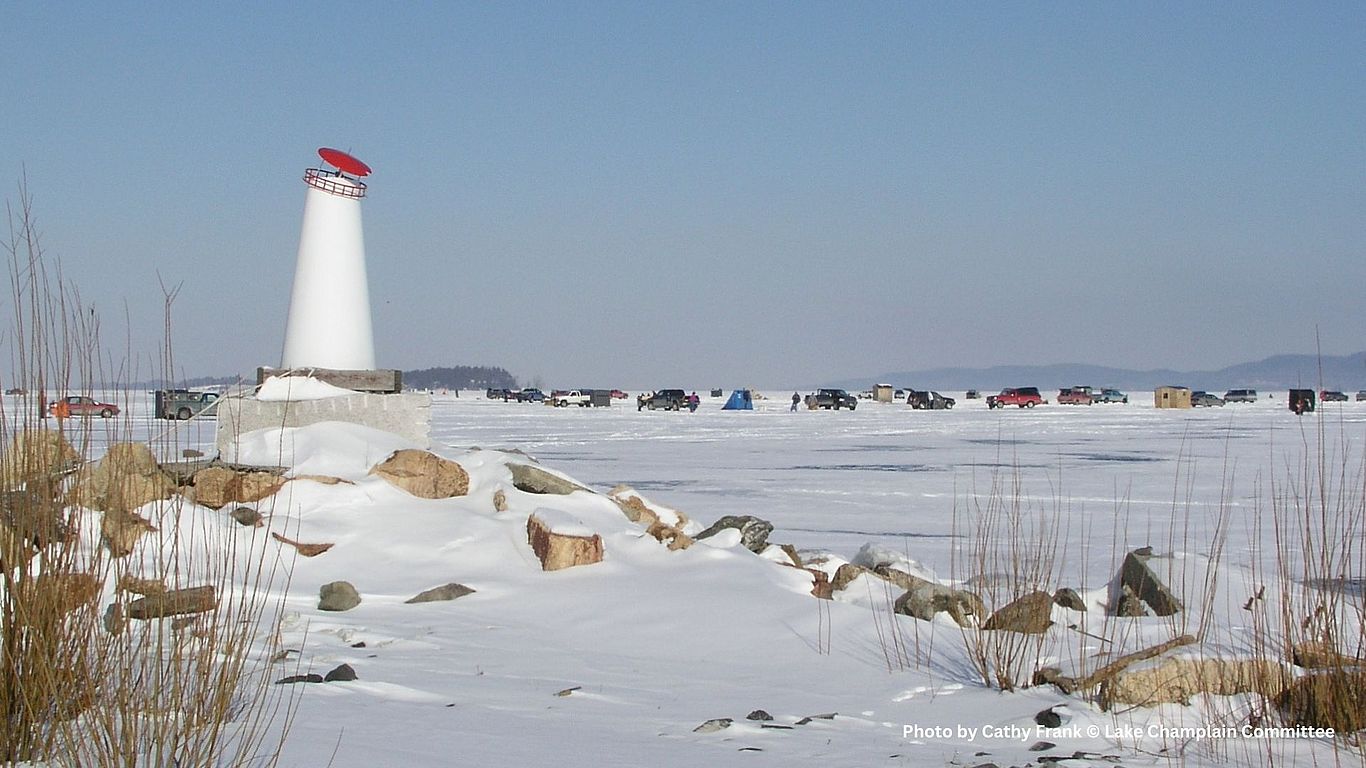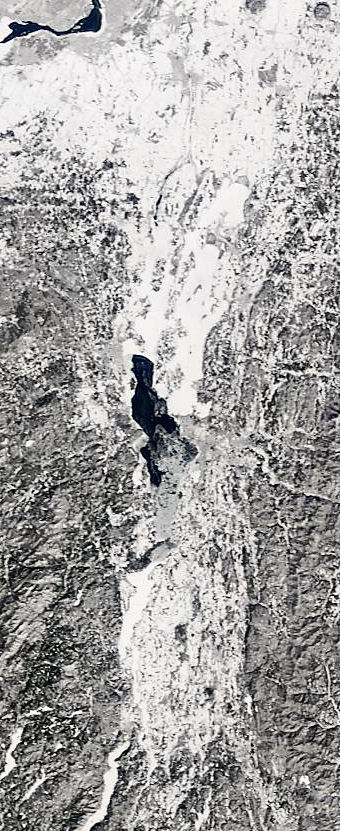All About Ice
Though it’s still early in 2023, it already has not been a banner year for ice on Lake Champlain. The lake is still largely unfrozen going into February. When record keeping on Lake Champlain freezing began in the 19th century, it was rare for a winter to go by without a complete freeze-over from shore to shore of the lake. This regular freezing created the basis for a seasonal culture of ice-centered activities, and the lack of ice this year and in the recent past is part of a concerning trend.

Ice fishing spans back millennia. While there are no exact records of the first person who ice fished on Lake Champlain, it is likely that this practice followed wherever the basic ingredients of ice, fish, and people were combined. Indigenous people of different tribes throughout the basin fished on ice, creating wind blocks from evergreen branches. Nowadays ice fishing is still a cultural staple for many. Both the New York Department of Environmental Conservation and the Vermont Department of Fish and Wildlife host ice fishing festivals or clinics that provide guidance to beginners in the sport and annually offer free ice fishing days where anyone can fish without a license. Vermont’s free fishing day is the last Saturday in January and New York will hold theirs during President’s Day Weekend.
Historically, people of the Champlain Basin have extracted not only fish from under the ice, but ice itself. Like ice fishing, ice harvesting has occurred on Lake Champlain for millenia. Ice was a wild harvested agricultural product before freezers were commonplace. Ice harvesting boomed in the mid-19th century as industrial tools for larger yields were invented. Harvesters would cut the ice into blocks and haul them on pulleys to be stored in ice houses before being shipped far and wide.

A completely frozen lake served also as a highway. According to the author of Adirondack Ice: A Cultural and Natural History, Caperton Tissot, horse-drawn sleds and stagecoaches ran regularly scheduled trips across the frozen lake between New York and Vermont up until the early 20th century. Travel on ice supported the shipment of food and other supplies, as well as people visiting friends and family across the lake. While that practice is lost, Lake Champlain is still legally a public thoroughfare when frozen—but bear in mind, the freeze thaw of recent years makes ice inherently unstable and ice needs to be at least 12 to 15 inches thick to safely accommodate vehicles. While it’s legally a “road” in its frozen state, Lake Champlain is not inspected and kept as a road even when this ice is thick enough to drive on.

For the past decade, Lake Champlain has frozen over completely just thrice—in 2014, 2015, and 2019. Full closure of ice on the lake was once the norm, but due to higher winter temperatures from climate change, a trend of less and less ice is apparent. Dr. Matthew Vaughan, scientist and technical coordinator at the Lake Champlain Basin Program, described the process of analyzing this data to create models of the future of ice on Lake Champlain. “We start with the database we have from the National Weather Service,”—this database has reliable records of whether or not the lake froze over completely dating back to1906—“[…] and we create a model to describe the probability of the lake freezing in the past.” By fitting this graph with a trendline that shows the frequency of lake freezing over the years, predictions can be made on the probability of lake freezing in the future.
Based on the trend of complete freezing of Lake Champlain, according to Dr. Vaughan, we can expect the lake to “close” about once every four years for the next few years—a profound difference from historical freezing and a decrease we can already observe. By around 2050, the frequency is expected to be even lower, with an estimated probability of closure just once every ten years. This trend corresponds with increased air temperatures. The daily minimum air temperature from December to March is rising in this region at a rate of 0.4oF per decade—a change that might seem minor, but is actually a dramatic warming and a more rapid increase than what we see with maximum summertime temperatures.
Ice, or the lack thereof, is perhaps the most dramatic visual we have for climate change in the Lake Champlain basin. This is not unique to Lake Champlain, but part of a trend observed worldwide. Warmer winter waters will pose a problem for cold-water fish species such as lake trout, which rely on the cold to open up a wider habitat range. It can also increase the frequency and duration of cyanobacteria blooms because cyanobacteria tend to like warmer waters. Non-lake dwellers like us once had a culture of ice, but our ability to live alongside and with swaths of frozen water is decreasing year by year. A sliver of hope given this melty trend is that climate change is a human-caused problem with human-driven solutions—it is up to us to slow down and adapt to our changing climate. While we may see more ice form as 2023 continues, it is important for us to take the messages of our unfrozen lake to heart.